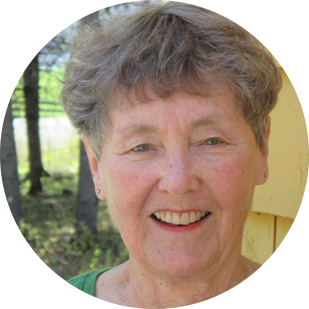Sue’s Story
“It is really important to understand about radon, because of course this kind of cancer is entirely preventable.”
Faces of Lung Disease:
Sue’s Story
Did You Know?
Radon gas is radioactive. It decays quickly, giving off tiny radioactive particles. When inhaled, these radioactive particles can damage the cells that line the lung.
Our hearts go out to the family and loved ones of Sue Rickards, who passed away on November 23, 2022. NB Lung has had the great pleasure of working with Sue since 2017, when she became an advocate for radon awareness after being diagnosed with lung cancer.
Sue’s contributions to social justice and public health causes in New Brunswick have impacted the lives of so many. Below are Sue’s own words that she has chosen to share with us to help shed light on radon-induced lung cancer.
In February of 2016 Sue Rickards had a routine chest x-ray. To her and her doctor’s surprise, Sue had lung cancer.
Sue has never smoked or vaped, or lived with someone who does. There was no family history of lung cancer, and Sue never spent much time in smoke-filled environment or places that would put her at risk of developing lung cancer.
Sue and her doctor began to look elsewhere for the cause, and it wasn’t long before they discovered that radon gas is the second leading cause of lung cancer, after smoking.
Luckily, Sue was friends with an expert in the field of environmental mitigation. When they tested her home they found exceptionally high levels of radon, well over 1,000 becquerels per cubic meter (1,000 Bq/m³).
Health Canada states that anything higher than 200 becquerels should be corrected. Sue and her doctor believe that radon gas was the cause of her lung cancer. Not long after, Sue had a radon mitigation system installed in her home, and now her home’s radon levels are well below the Health Canada limit.
After her diagnosis, in May of 2016, Sue needed surgery to remove part of one of her lungs. Things were fine until four years later when she started having aches in her head. Not headaches, but rather pain in her skull. A CT scan revealed that her lung cancer had metastasized to her bones. Within just twenty days, Sue was a Stage 4 Oncology patient. This type of cancer has the highest rate of mortality.

“It is really important to understand about radon, because of course this kind of cancer is entirely preventable. Don’t pity me; just don’t let it happen to you or your loved ones.
Test your home for radon.”
Rest in peace Sue, NB Lung is forever grateful for your dedication to public education.
When we created this video together in 2021, Sue was in high spirits and was living a happy and productive life. She worked with us for many years to educate New Brunswickers about the dangers of radon.
Page Last Updated: 28/02/2023
